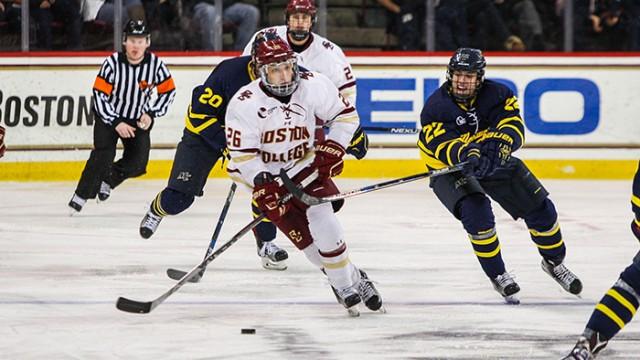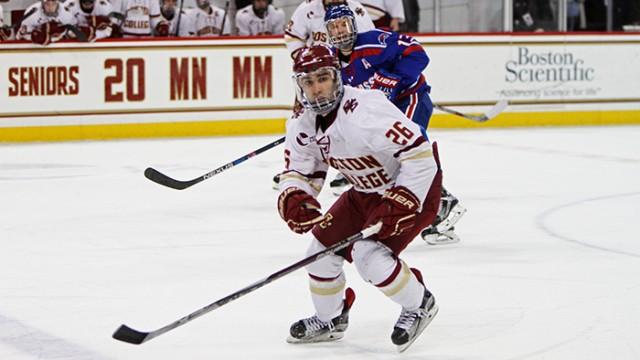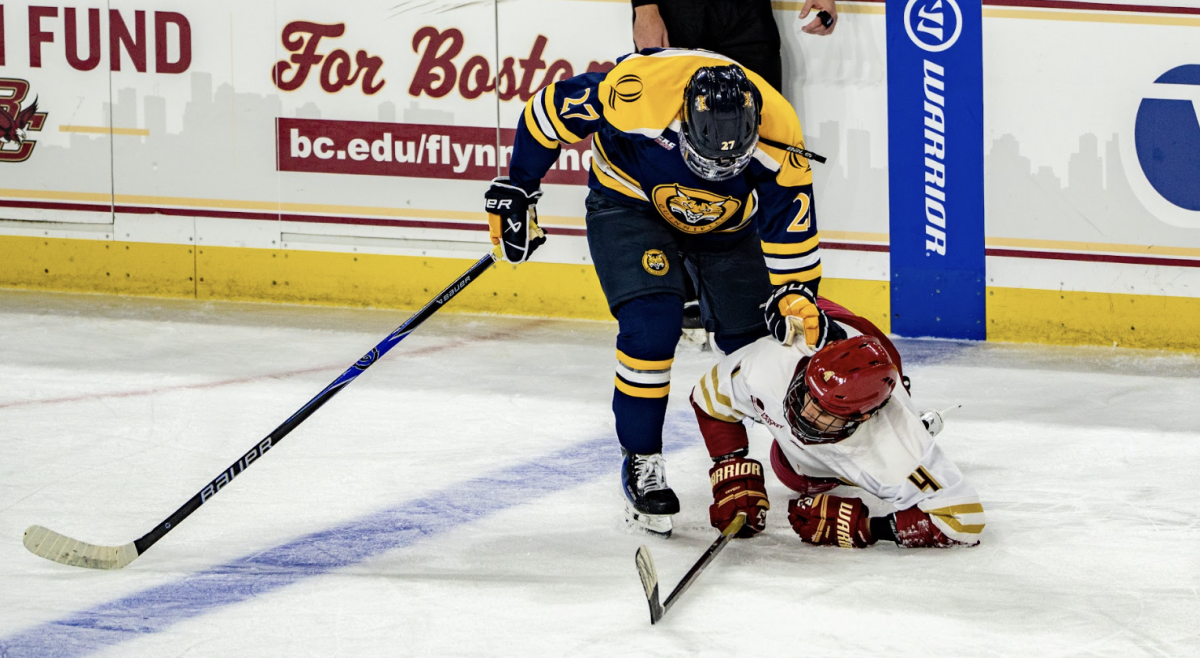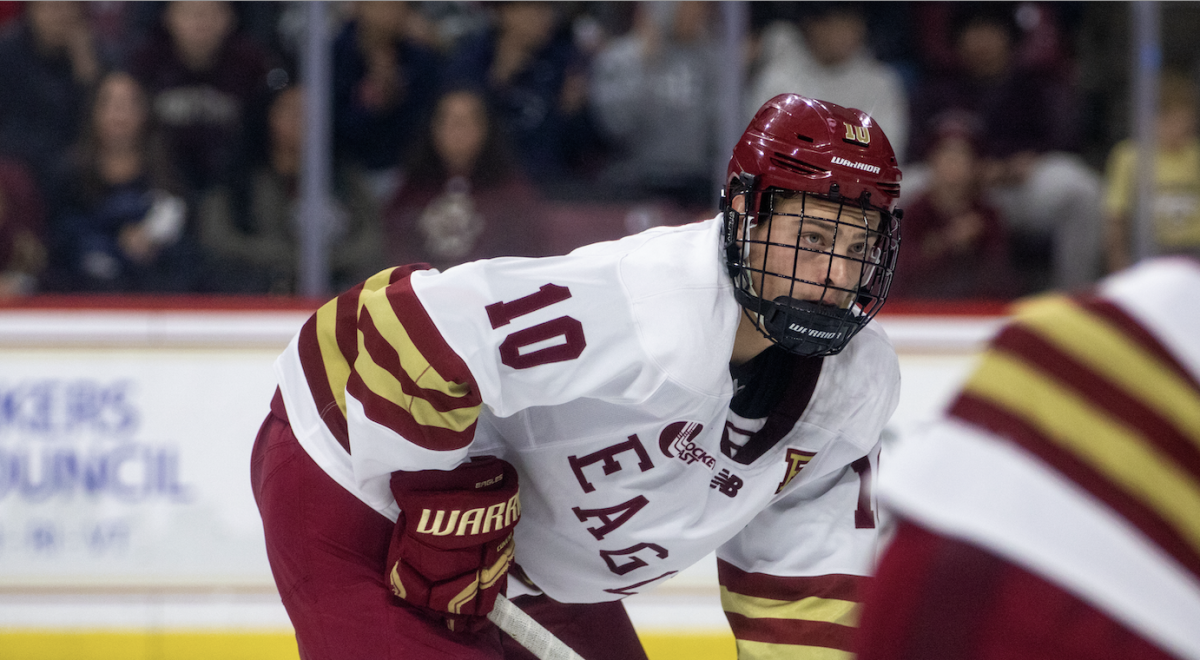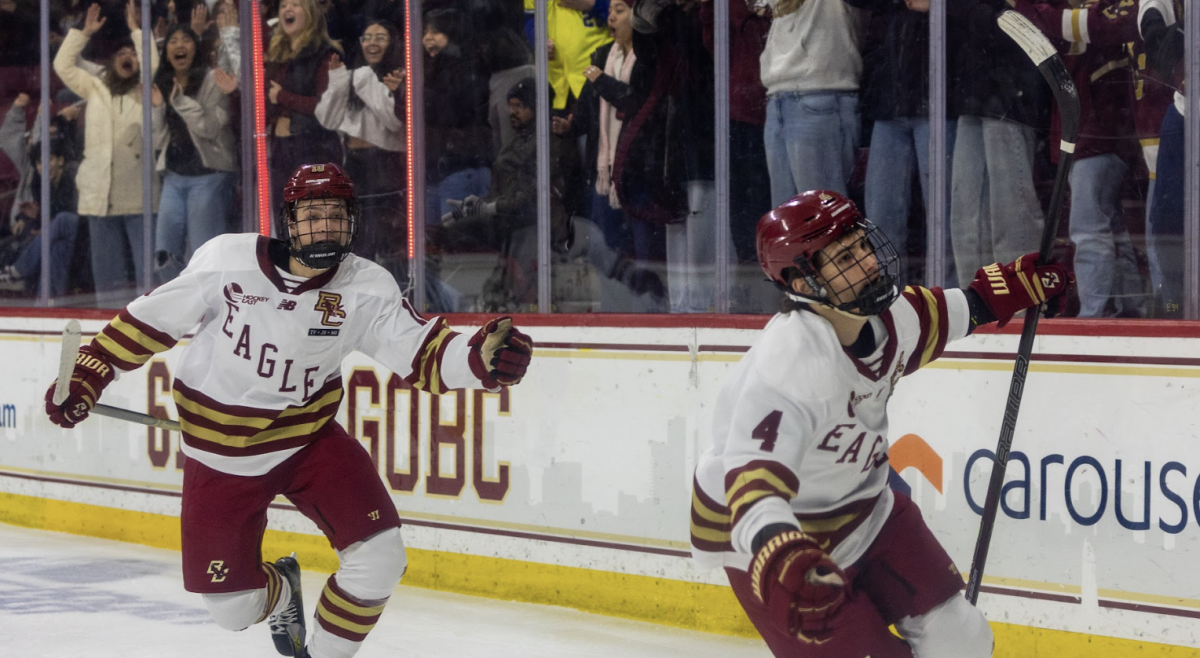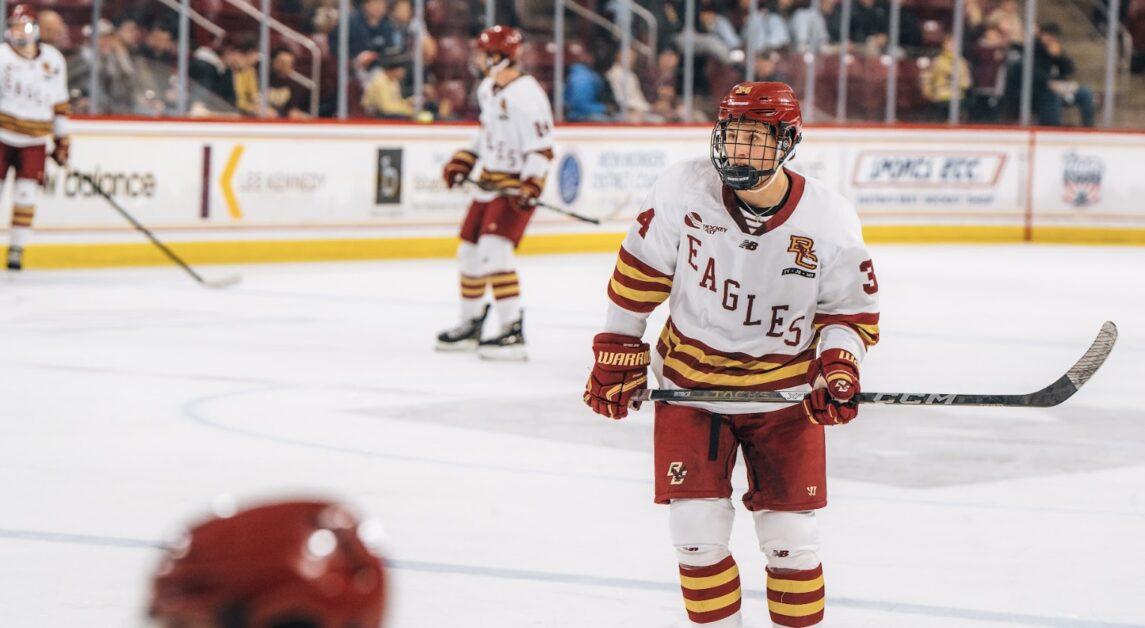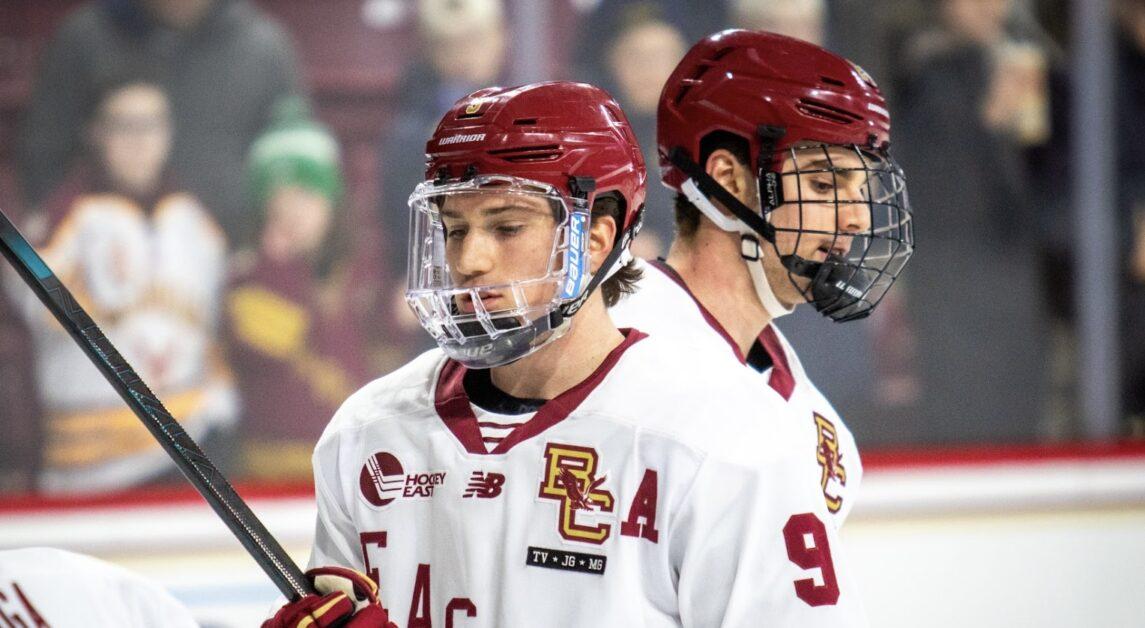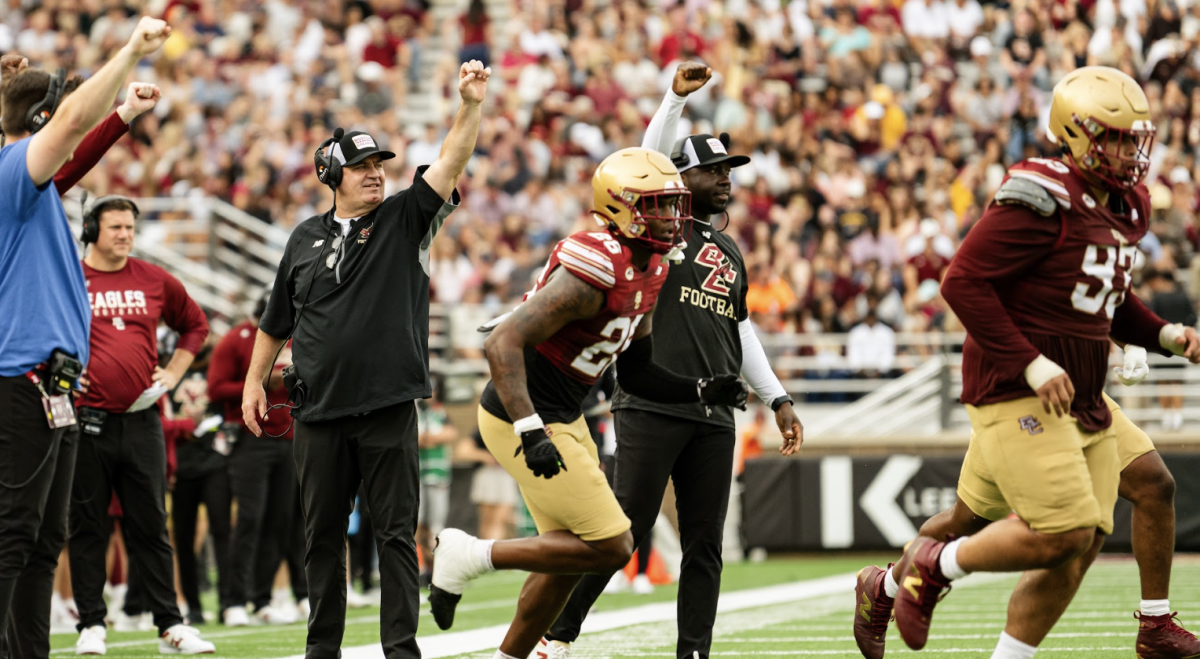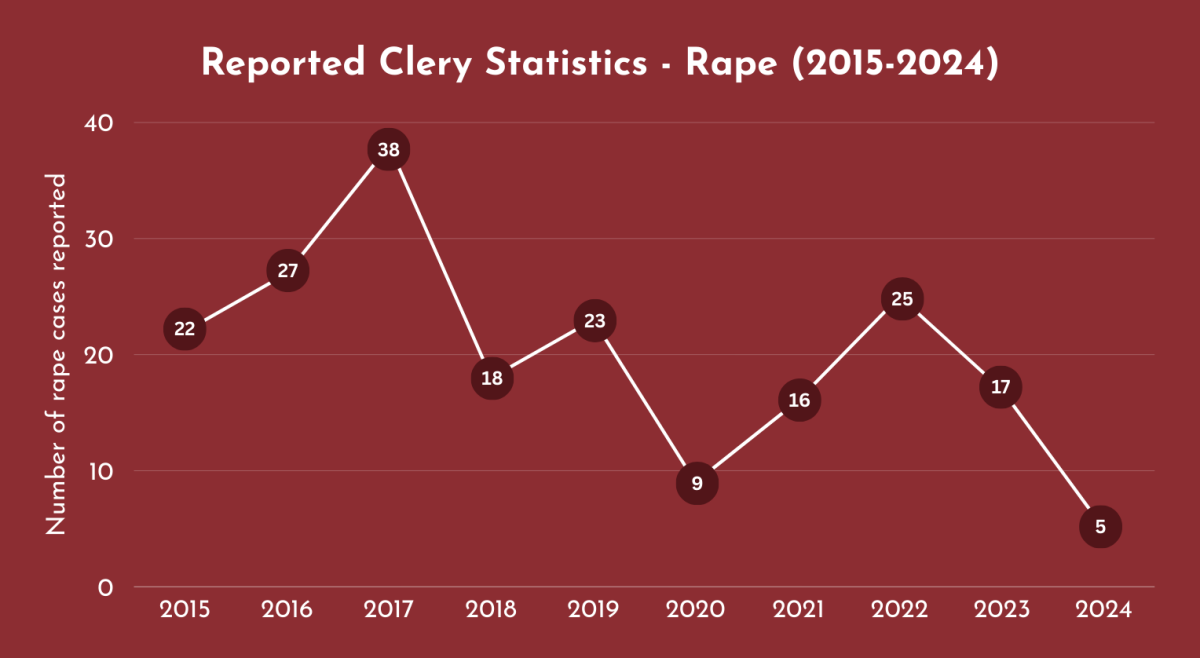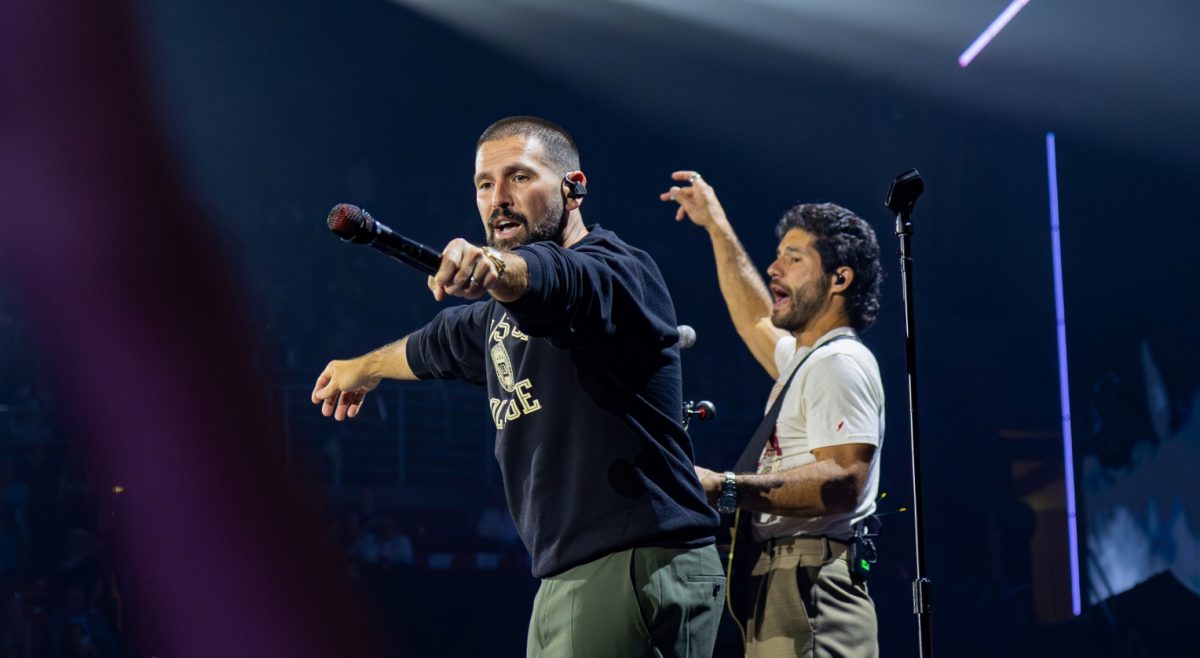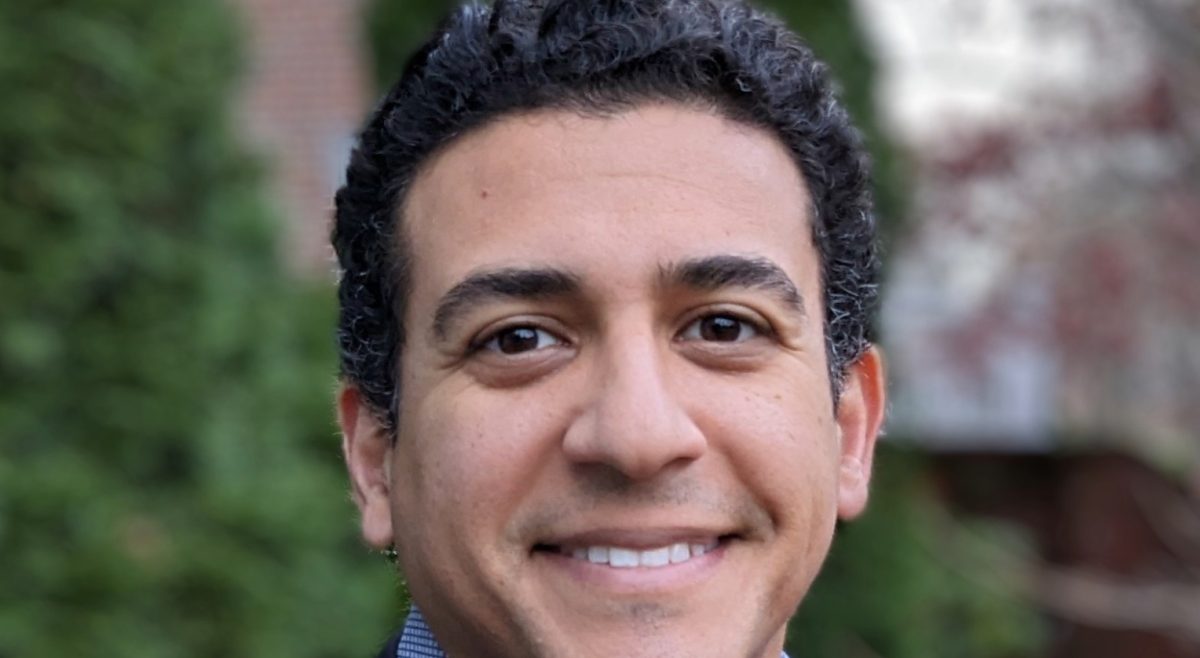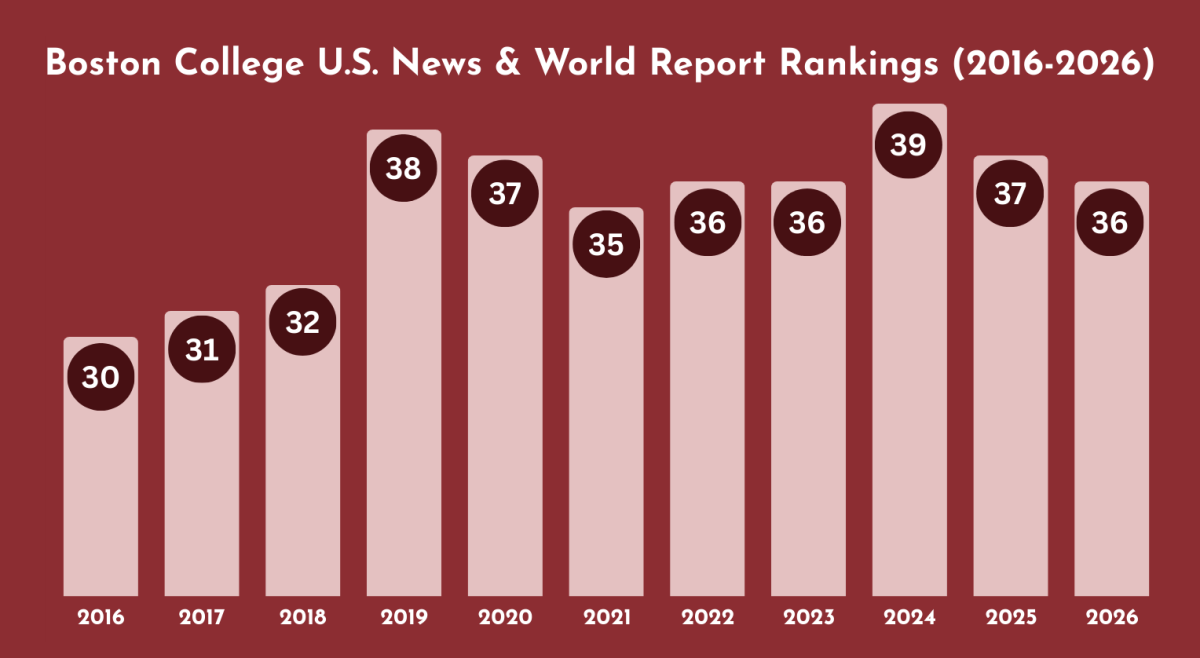Who do you think is the most important forward for Boston College?
Maybe Colin White, the freshman superstar bound for Ottawa, whose absence has led to three of the Eagles’ five losses. Perhaps North Reading, Mass. native Ryan Fitzgerald, who led the team in points in the regular season (40, on 20 goals and 20 assists). I’d even accept the tag team of BC’s bruising 6-foot-4 forwards—Zach Sanford and Alex Tuch—as a reasonable response.
Nope. You’re all wrong. The answer is—wait for it—Austin Cangelosi.
Yes, Cangelosi, the shortest man on the roster (at a generous 5-foot-7), one who has been nothing more than a secondary contributor in his first two seasons, and one of the only players on the team who remains undrafted. That’s the guy who, save for Thatcher Demko, the Eagles need more than anyone else.
In head coach Jerry York’s esteemed opinion, no forward has improved more over his career at BC than Cangelosi. As a freshman, in the electric offense led by Johnny Gaudreau, Kevin Hayes, and Bill Arnold, Cangelosi found a niche. He scored 10 goals and 16 assists in 40 games as the Eagles made a run at the Frozen Four. Last year, in 37 games, his production dipped to only six goals and 14 assists.
But through only 34 games this season, Cangelosi finds his name among the nation’s leading scorers. He has 31 points on 16 goals and 15 assists, tied for 52nd in the country and fourth-best among the Eagles. And his contributions go well beyond that, to the point where York has no hesitation in lauding his greatness.
“I think this year he’s become, in my opinion, an all-league type player,” York said last week at practice.
How has Cangelosi grown into such a weapon? Let’s harken back to the loudest moment at Kelley Rink this season.
Despite Winter Break’s sapping the student section from its most beloved supporters, Kelley Rink still reached high-decibel counts on Jan. 15 in BC’s 5-3 victory over hated rival Boston University. Cangelosi made sure it hit its peak.
In the middle of the second period, the junior from Estero, Fla. lined up against Terriers goaltender Sean Maguire looking to convert on the first BC penalty shot since Chris Kreider’s more than four years ago. He stared down his opponent between the pipes before coming at him with incredible force from BC’s own blue line, straight on. When he reached the top of the circles, Cangelosi came to an abrupt halt, only allowing his momentum to propel him toward the net. He expertly deked back and forth, causing Maguire to become dizzy. After 15 swift movements of his stick, Cangelosi found his perfect moment. Maguire looked too far to the right when Cangelosi put the puck on his left side, making him lean too far that way. That gave Cangelosi just enough of an opening to the right to smack the puck home past Maguire’s left pad.
WHAT pic.twitter.com/JTmkx7w1XR
— Grant Salzano (@Salzano14) January 16, 2016
Once is luck, but twice is a trend. And Cangelosi is the type of player who prefers trends.
Less than a month later, Cangelosi got another penalty shot opportunity, this time against Merrimack’s Collin Delia. Again, he went back to his move. He sprinted up from the blue line, slowed down at the circles, and began his dekes. As he did, Cangelosi analyzed his foe like an English major tries to process James Joyce. This time, he took advantage of the fact that Delia pushed his stick out in front of him too far to try and poke away Cangelosi’s attempt. That move gave Cangelosi enough time to go for the five-hole and extend BC’s lead. And, of course, his celebration was just as much of a success, as he channelled Fiddle Kid by creating a make-believe violin.
Cangelosi said it didn’t come without trial and error. He worked a lot with Demko whenever he got the chance at practice. He believes the change in speeds is important, especially when you slow down. That part, coupled with expert stickhandling, Cangelosi says, is the key to confusing the goaltender. If you can master that, it gives you time to study the goalie. And, in all likelihood, you’ll get two options. If the five-hole opens up, as it did against Merrimack, go there. If not, fake to the backhand and opt for the forehand. Reference the BU goal for that one.
Thankfully for Cangelosi, the only netminder who can stop his move won’t be much of a problem for him.
“Thatcher saves it every time,” Cangelosi admitted. “I don’t think I’ve scored against him doing that all year.”
Of course, in Hockey East play, penalty shots don’t come in handy all that often. The conference hasn’t caught up to the Big Ten or NCHC in resolving things with shootouts. Instead, we must settle for the boring tie. And trust me, I’ve been through a lot of them.
Cangelosi doesn’t just score when he’s all alone with the goaltender. As stated earlier, he has already reached a career-high in goals and points. He does it, however, with acute selectivity and accuracy. Cangelosi has taken only 68 shots, seventh-most on the Eagles. But he succeeds at an outstanding 23.5 percent rate, by far the best on the team. Teddy Doherty sits at the No. 2 slot, yet only hits the twine 17.7 percent of the time.
And when he isn’t attacking the net himself, he’s setting up others for success. How? By being the country’s best center off the draw.
Cangelosi has the highest percentage of successful faceoffs in the country among centers. He has won 453 to only 258 losses, a 63.7 percent rate. That’s 1.5 percent higher than the next closest center, Union’s Mike Vecchione—a large margin for a statistic in which players are so close together. And BC’s next best man off the draw is Fitzgerald, who wins them only 54.9 percent of the time.
He gets excellent leverage on the puck, especially on 50-50 draws. And it’s not just that he wins the puck—he places it in the ideal spot to create scoring opportunities. He consistently attempts to bring it back to the defensive zone, or, if he has his way, right to the stick of his winger, Miles Wood. Because, as he’ll tell you, good things will happen when the freshman rips a shot off.
To York, Cangelosi’s greatest asset is as a leader for Wood and fellow linemate, Adam Gilmour.
Cangelosi is notably disciplined, taking only three minor penalties this season. Wood, however, sits on the other end of the spectrum. The freshman has taken 21 penalties, tied for 15th-most in the nation, for a total of 72 minutes, tied for third-most. That doesn’t even take into account Wood’s two suspensions. But York believes that Cangelosi, by setting an example in practice and using his expert positive-influence skills, has immensely helped Wood’s growth.
“We’ve had 93 practices and if I had to go back over all of them, he’d be consistently one of the top-three hardest workers,” York said.
Obviously, Gilmour, Cangelosi’s classmate, doesn’t need those leadership skills. But York asserts that the center has given him a much-needed boost. Last season, Gilmour was one of BC’s most critical offensive players. He scored nine goals and 18 assists on 27 points while playing center in between the two freshman wings, Tuch and Sanford.
But Gilmour hasn’t capitalized on that momentum from last year. In the beginning of the season, Gilmour moved over to the wing to allow Sanford to develop at center, his natural position. Yet their chemistry lacked with the new arrangement, and the three all struggled to score. And with Jeremy Bracco’s sudden departure, York and his staff were hampered by their lack of defensive depth.
That changed when defenseman and first-semester freshman Michael Kim arrived for the Providence series. His inclusion and the quick transition to the college game by Casey Fitzgerald and Josh Couturier gave York the confidence to permanently move Doherty to left wing on Tuch and Sanford’s line. This, in turn, allowed him to drop Gilmour to the right wing alongside Cangelosi and Wood, moving their original right winger, Christopher Brown, to the fourth line with Travis Jeke and, when healthy, Chris Calnan.
York’s decision to move Gilmour may have been the spark that has made his group of forwards elite. Because of that shuffling, the Eagles—again, when healthy—have four lines that all have a perfect, humming harmony, and can put up points at will. In the 13 games since Gilmour moved to that line, the Eagles are a superb 9-1-3.
But York credits Cangelosi for easing that transition with Gilmour, who has performed much better of late, including an impressive two-game stretch against Merrimack. And, in turn, Cangelosi is grateful for the decision to put Gilmour with him and Wood.
“We love to compete,” Cangelosi said of his linemates. “We love getting after pucks, and grinding out. Oh, and scoring goals too.”
Perhaps we should’ve seen this kind of confidence coming. After all, Cangelosi is no stranger to success. He showed off in the USHL with the Youngstown Phantoms, including a goal that helped them advance in that season’s playoffs. Even back then, people urged NHL teams to gamble on the small yet effective Cangelosi. Many drew comparisons to another undersized BC forward: Johnny Gaudreau. And despite his size, that guy is doing pretty well for himself right now in the bigs. There have been rumors that NHL squads are finally starting to pick up on that idea that size doesn’t matter when it comes to Cangelosi, most notably the New York Islanders, with whom he practiced in mini camp during this past summer.
But right now, Cangelosi doesn’t worry about the next level. Like any York disciple, he has his eyes set on a title. The first step is getting back to TD Garden in the Hockey East tournament. BC hasn’t gotten past the second round since 2013—only the seniors know what it’s like to go for a conference title. Currently, that’s Cangelosi’s mission. After that, well, you can probably guess.
“I love playing, being in the moment, and chasing another championship,” he said.
Featured Image by Drew Hoo / Heights Editor
Gallery Images by Julia Hopkins / Heights Editor | Alec Greaney / Heights Editor

